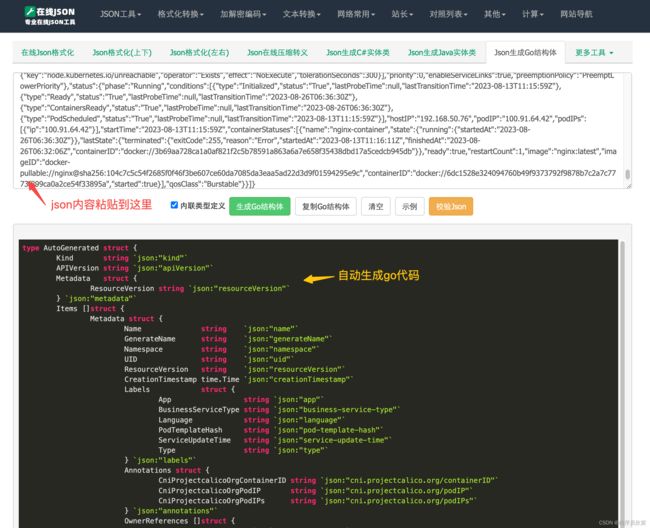Kubernetes对象深入学习之五:TypeMeta无效之谜
欢迎访问我的GitHub
这里分类和汇总了欣宸的全部原创(含配套源码):https://github.com/zq2599/blog_demos
本篇概览
- 本文是《Kubernetes对象深入学习之五》系列的第五篇,从前文的分析也能看出,代表对象类型的schema.ObjectKind,于对象而言是至关重要的,那是它的类型和身份,既然如此,与之有关的问题也不能放过,因此本篇就来看一个对象类型相关的问题,本文由以下内容组成:
- 复现问题:我的代码中获取的对象类型为空
- 问题原因
- 为什么会有这个问题?
- 这个问题有解吗?
复现问题
- 问题很容易复现,回顾《Kubernetes对象深入学习之四:对象属性编码实战》的代码,controller.go有下面这么一段代码,作用是在controller监听到对象变化时,将对象的ObjectMeta内容在控制台打印出来,现在咱们在黄色箭头前面添加两端代码

- 新增的代码是下面这些,先用现成的方法做一次提取,得到Kind和APIVersion,再尝试直接转换成objectruntime.Object类型获取GVK
// 第一次尝试:通过公共方法转为Type接口
objType, err := meta.TypeAccessor(obj)
if err != nil {
klog.Errorf("TypeAccessor [%s], failed with %v", key, err)
return err
}
fmt.Printf("** 通过公共方法获取Kind, kind [%s], version [%s]\n", objType.GetKind(), objType.GetAPIVersion())
// 第二次尝试:亲自尝试强转
runtimeObj, _ := obj.(objectruntime.Object)
fmt.Printf("** 强转获取Kind: %v\n", runtimeObj.GetObjectKind().GroupVersionKind())
I0827 01:15:58.890491 2945049 controller.go:144] Starting Pod controller
** 通过公共方法获取Kind, kind [], version []
** 强转获取Kind: /, Kind=
** 通过公共方法获取Kind, kind [], version []
** 强转获取Kind: /, Kind=
** 通过公共方法获取Kind, kind [], version []
** 强转获取Kind: /, Kind=
- 好了,现在问题已复现:TypeMeta内容为空,接下来去寻找问题原因
问题原因
-
咱们按照顺序捋一下代码,在main.go中调用了CreateAndStartController来创建controller,此时指定了类型是&v1.Pod{}

-
在CreateAndStartController方法内会调用NewListWatchFromClient来创建ListWatcher,指定了resource就是刚才传入的pods

-
继续展开,就看到了关键代码NewFilteredListWatchFromClient方法,这里指出了list操作的具体实现,该方法其余代码略去不看了:
func NewFilteredListWatchFromClient(c Getter, resource string, namespace string, optionsModifier func(options *metav1.ListOptions)) *ListWatch {
listFunc := func(options metav1.ListOptions) (runtime.Object, error) {
optionsModifier(&options)
return c.Get().
Namespace(namespace).
Resource(resource).
VersionedParams(&options, metav1.ParameterCodec).
Do(context.TODO()).
Get()
}
// 剩余的代码省略不看
...
}
- 注意,重点来了,先展开上面的Do方法,这里面发起了远程请求,获取资源列表,并且指定transformResponse方法用来处理收到的响应
func (r *Request) Do(ctx context.Context) Result {
var result Result
err := r.request(ctx, func(req *http.Request, resp *http.Response) {
result = r.transformResponse(resp, req)
})
if err != nil {
return Result{err: err}
}
return result
}
- 这个transformResponse方法的代码太多,我们只关注重点,就是这个decoder对象,记住这个decoder

- 看完了Do方法,再来看Get方法,关键代码是黄色箭头指出的部分:使用decoder对响应的body进行处理

- 再来看这个Decode方法的内容([email protected]/pkg/runtime/helper.go),很明显,这里故意调用了SetGroupVersionKind方法,入参是个新的GroupVersionKind对象,如此一来,所有类型有关的信息就被清除了
// Decode does not do conversion. It removes the gvk during deserialization.
func (d WithoutVersionDecoder) Decode(data []byte, defaults *schema.GroupVersionKind, into Object) (Object, *schema.GroupVersionKind, error) {
obj, gvk, err := d.Decoder.Decode(data, defaults, into)
if obj != nil {
kind := obj.GetObjectKind()
// clearing the gvk is just a convention of a codec
kind.SetGroupVersionKind(schema.GroupVersionKind{})
}
return obj, gvk, err
}
- 至此,真相大白,kubernetes官方在处理api-server的响应内容时,刻意将TypeMeta清理掉了
为什么会有这个问题?
- 对于这么做的原因,首先是个人猜测,回到main.go,如下图,作为使用方,既然已经明确了要监听的资源是pod,那么得到的结果自然就只能是v1.Pod了,所以无需再从结果中获取类型,

- 至于根本原因,由于欣宸英语水平太差,未能从一群老外的讨论中得到明确答案,下面是和这个问题相关的pr和issue,可见抱有相同疑惑的人着实不少,并且这个问题已经持续多年,并且一直没有解决:
- https://github.com/kubernetes/kubernetes/pull/59264#issuecomment-362579495
- https://github.com/kubernetes/client-go/issues/541
- https://github.com/kubernetes/client-go/issues/861
- https://github.com/kubernetes/kubernetes/issues/80609
这个问题可以解决吗?
raw : {"kind":"PodList","apiVersion":"v1","metadata":{"resourceVersion":"12435998"},"items":[{"metadata":{"name":"nginx-deployment-78f6b696d9-cr47w","generateName":"nginx-deployment-78f6b696d9-","namespace":"client-go-tutorials","uid":"645628af-0d20-4548-b15d-0faf9e03b733","resourceVersion":"12227486","creationTimestamp":"2023-08-13T11:15:59Z","labels":{"app":"nginx-app","business-service-type":"web","language":"c","pod-template-hash":"78f6b696d9","service-update-time":"20230813120623","type":"front-end"},"annotations":{"cni.projectcalico.org/containerID":"e94b7b0ebe60d1cada361f7a672b2c6df71f2d89c4b5c1ae4056f82dec6a78db","cni.projectcalico.org/podIP":"100.91.64.45/32","cni.projectcalico.org/podIPs":"100.91.64.45/32"},"ownerReferences":[{"apiVersion":"apps/v1","kind":"ReplicaSet","name":"nginx-deployment-78f6b696d9","uid":"642c39e7-814a-491f-9b4f-295f34e959a3","controller":true,"blockOwnerDeletion":true}],"managedFields":[{"manager":"kube-controller-manager","operation":"Update","apiVersion":"v1","time":"2023-08-13T11:15:59Z","fieldsType":"FieldsV1","fieldsV1":{"f:metadata":{"f:generateName":{},"f:labels":{".":{},"f:app":{},"f:business-service-type":{},"f:language":{},"f:pod-template-hash":{},"f:type":{}},"f:ownerReferences":{".":{},"k:{\"uid\":\"642c39e7-814a-491f-9b4f-295f34e959a3\"}":{}}},"f:spec":{"f:containers":{"k:{\"name\":\"nginx-container\"}":{".":{},"f:image":{},"f:imagePullPolicy":{},"f:name":{},"f:resources":{".":{},"f:limits":{".":{},"f:cpu":{},"f:memory":{}},"f:requests":{".":{},"f:cpu":{},"f:memory":{}}},"f:terminationMessagePath":{},"f:terminationMessagePolicy":{}}},"f:dnsPolicy":{},"f:enableServiceLinks":{},"f:restartPolicy":{},"f:schedulerName":{},"f:securityContext":{},"f:terminationGracePeriodSeconds":{}}}},
...
..
.
- 拿到这样的json内容后,去工具网站转为go的数据结构代码,这样就能在代码中完成反序列化,例如:https://zxjson.com/json2go/, 如下图,转为go的数据接口

- 如此一来,跌跌撞撞的拿到了完整的json对象,当然了,这并不是个好的办法
- 至此ypeMeta无效之谜已经解开,如果您有更好的解法或者更多官方消息,欢迎留言,感谢您的帮助
你不孤单,欣宸原创一路相伴
- Java系列
- Spring系列
- Docker系列
- kubernetes系列
- 数据库+中间件系列
- DevOps系列

